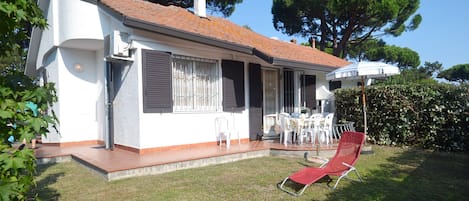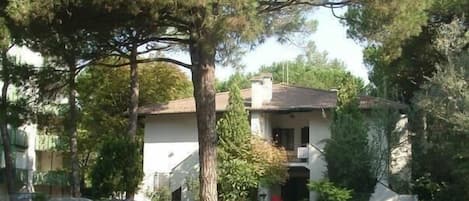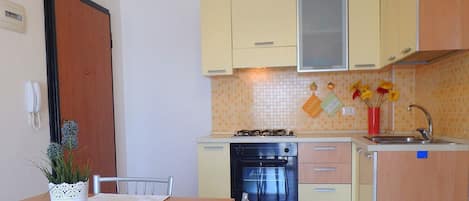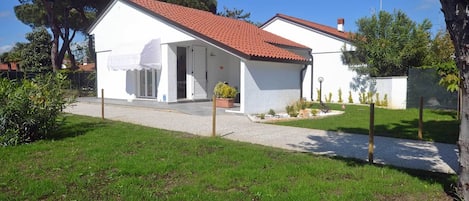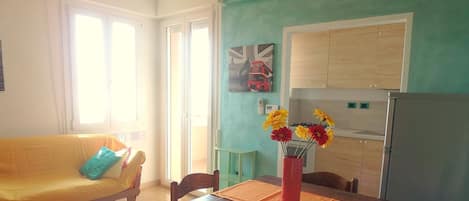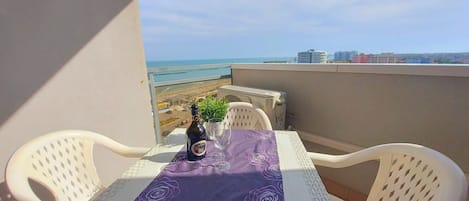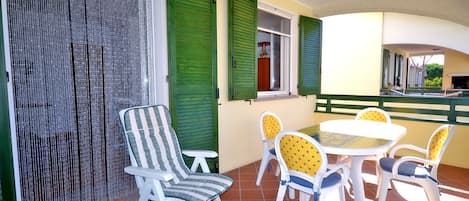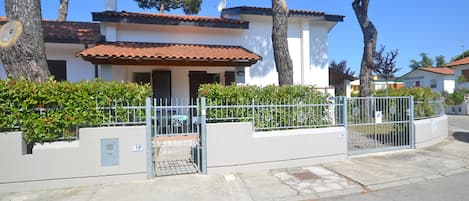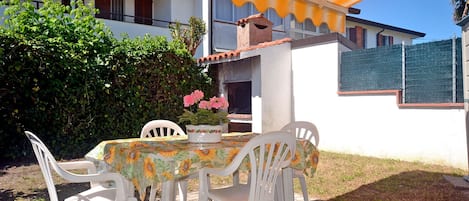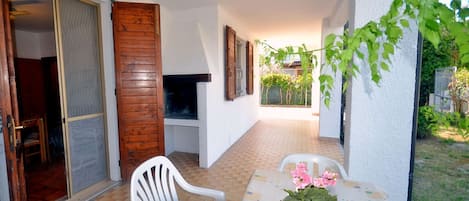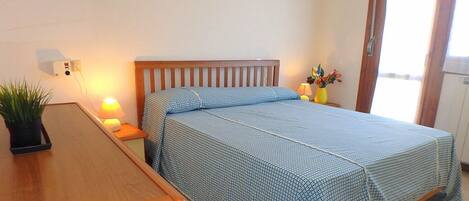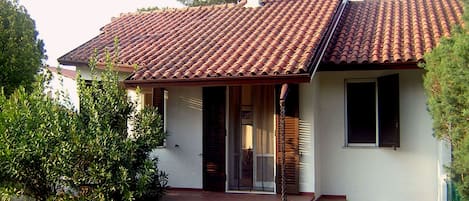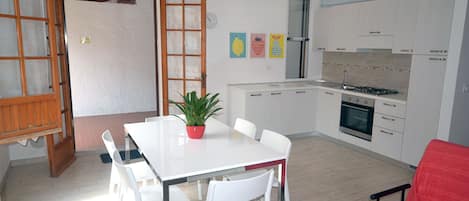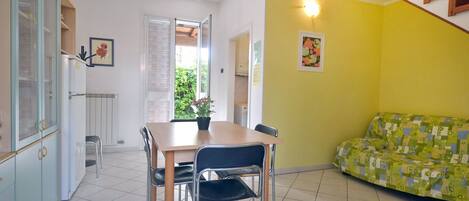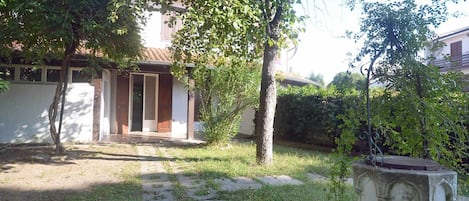Maison entière·Hôte professionnel
Villa Sole Very brand new semi-detached villa, with air conditioning and garden
Maison de vacances de Comacchio
Galerie photos de l’hébergement Villa Sole Very brand new semi-detached villa, with air conditioning and garden



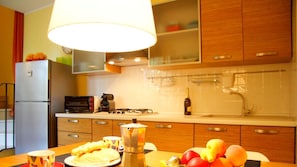
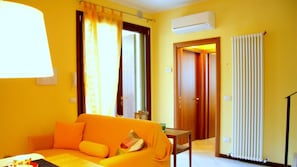
Avis voyageurs
8,0 sur 10
Très bien
2 chambres1 salle de bain5 personnes50 m²
Équipements populaires
Découvrir la zone

Comacchio, Ferrara
- Place, Circuit de Pomposa16 min à pied
- Place, Marais Valli di Comacchio3 min en voiture
- Place, Parc à thèmes Mirabilandia59 min en voiture
Chambres et lits
2 chambres (5 personnes)
Chambre 1
1 lit double et 1 lit 1 place
Chambre 2
1 lit double
1 salle de bain
Salle de bain 1
Toilettes · Douche uniquement
Protégez vos paiements : réservez toujours sur Abritel.
N’acceptez jamais les demandes suspectes et utilisez toujours les moyens de réservation offerts sur notre site ou notre appli. Si une personne vous demande de réserver ou de payer directement auprès d’elle avant que vous effectuiez votre réservation sur Abritel, veuillez ne pas lui répondre et nous le signaler.
À propos de cet hébergement
Villa Sole Very brand new semi-detached villa, with air conditioning and garden
Semi-detached villa recently built, developed on two floors with air conditiong and garden, in residential context at Lido degli Scacchi.
Comacchio is about 10 km away and is the most original and fascinating historical center in Po Delta Park.
Origin of the ancient Spina, long controversial from Ferrara and Ravenna, by the Popes and Emperors, has ancient origins: it rises in fact at the dawn of the Middle Ages, when the initial settlement settled on a chain of islets emerging in the evergreen mouth of the Padana.
Fishing, shellfish, salt production were the source of its flourishingness and its overturns, due to the conflicts that opposed it to Venice. After the Estense era, during the Pontifical State, the city revived, so much so that the happiest architectural and monumental interventions dates back to the sixth-eighteenth century.
Now Comacchio is a lagoon town that enchants: it is gentle and genuine, with a vitality that is lymph in respect to its own history and the desire to valorize it. A widespread reminder remembers the proximity to the sea, whose light fills the urban spaces, even more potentiated by the quiet areas of the canals.
The town of Comacchio and its valleys represent the "heart" of the Delta, are in fact the green lungs of the whole Adriatic coast from Chioggia to Cattolica. The Comacchio Lagoon are the real museum and represent one of the most important lagoon complexes in Italy and Europe. They extend to the provinces of Ferrara and partly to Ravenna, for more than 11,000 hectares, between Comacchio and the River Reno, and are connected to the sea through the channels of Magnavacca, Logonovo, Bellocchio and Gobbino. Formations of brackish water, they represent an important biotope of brackish water wet zone, made up of extreme alofil vegetation and declared of international interest, according to the Ramsar Convention of 1971.
Around the lagoon the historical and economic history of Comacchio has been centered and developed; this is an almost unique example of integration between the natural environment and human activity, where salt production and fisheries have always represented the primary economic bases, to which local craftsmanship was predominantly linked, being almost agriculture is absent and tourism is completely lacking. These latest economic components have developed almost simultaneously with the reclamation and draining of thousands of acres of lagoon, leaving unchanged that part of which is still practiced especially eel fishing with special instruments named Lavoriero.
The total surface is formed by the lagoon "Fossa di Porto" (including Zavelea oasis), "Lido di Magnavacca", "Fattibello" (which in the past was not far used for fishing as a daily livelihood) and "Campo"; has a morphology articulated because of:
artificial crevices created to delineate the catchment basins of the bush, barene and ancient dunosis emerging from the waters.
Boscoforte Peninsula is a very suggestive sandy tongue, extending from the Reno River between the lagoon "Fossa di Porto" and "Lido di Magnavacca" for a length of 6 km, formed by the expanse of a dune-coastal cordon of the Etruscan period .
Semi-detached villa recently built, developed on two floors with air conditiong and garden, in residential context at Lido degli Scacchi.
Comacchio is about 10 km away and is the most original and fascinating historical center in Po Delta Park.
Origin of the ancient Spina, long controversial from Ferrara and Ravenna, by the Popes and Emperors, has ancient origins: it rises in fact at the dawn of the Middle Ages, when the initial settlement settled on a chain of islets emerging in the evergreen mouth of the Padana.
Fishing, shellfish, salt production were the source of its flourishingness and its overturns, due to the conflicts that opposed it to Venice. After the Estense era, during the Pontifical State, the city revived, so much so that the happiest architectural and monumental interventions dates back to the sixth-eighteenth century.
Now Comacchio is a lagoon town that enchants: it is gentle and genuine, with a vitality that is lymph in respect to its own history and the desire to valorize it. A widespread reminder remembers the proximity to the sea, whose light fills the urban spaces, even more potentiated by the quiet areas of the canals.
The town of Comacchio and its valleys represent the "heart" of the Delta, are in fact the green lungs of the whole Adriatic coast from Chioggia to Cattolica. The Comacchio Lagoon are the real museum and represent one of the most important lagoon complexes in Italy and Europe. They extend to the provinces of Ferrara and partly to Ravenna, for more than 11,000 hectares, between Comacchio and the River Reno, and are connected to the sea through the channels of Magnavacca, Logonovo, Bellocchio and Gobbino. Formations of brackish water, they represent an important biotope of brackish water wet zone, made up of extreme alofil vegetation and declared of international interest, according to the Ramsar Convention of 1971.
Around the lagoon the historical and economic history of Comacchio has been centered and developed; this is an almost unique example of integration between the natural environment and human activity, where salt production and fisheries have always represented the primary economic bases, to which local craftsmanship was predominantly linked, being almost agriculture is absent and tourism is completely lacking. These latest economic components have developed almost simultaneously with the reclamation and draining of thousands of acres of lagoon, leaving unchanged that part of which is still practiced especially eel fishing with special instruments named Lavoriero.
The total surface is formed by the lagoon "Fossa di Porto" (including Zavelea oasis), "Lido di Magnavacca", "Fattibello" (which in the past was not far used for fishing as a daily livelihood) and "Campo"; has a morphology articulated because of:
artificial crevices created to delineate the catchment basins of the bush, barene and ancient dunosis emerging from the waters.
Boscoforte Peninsula is a very suggestive sandy tongue, extending from the Reno River between the lagoon "Fossa di Porto" and "Lido di Magnavacca" for a length of 6 km, formed by the expanse of a dune-coastal cordon of the Etruscan period .
Comacchio is about 10 km away and is the most original and fascinating historical center in Po Delta Park.
Origin of the ancient Spina, long controversial from Ferrara and Ravenna, by the Popes and Emperors, has ancient origins: it rises in fact at the dawn of the Middle Ages, when the initial settlement settled on a chain of islets emerging in the evergreen mouth of the Padana.
Fishing, shellfish, salt production were the source of its flourishingness and its overturns, due to the conflicts that opposed it to Venice. After the Estense era, during the Pontifical State, the city revived, so much so that the happiest architectural and monumental interventions dates back to the sixth-eighteenth century.
Now Comacchio is a lagoon town that enchants: it is gentle and genuine, with a vitality that is lymph in respect to its own history and the desire to valorize it. A widespread reminder remembers the proximity to the sea, whose light fills the urban spaces, even more potentiated by the quiet areas of the canals.
The town of Comacchio and its valleys represent the "heart" of the Delta, are in fact the green lungs of the whole Adriatic coast from Chioggia to Cattolica. The Comacchio Lagoon are the real museum and represent one of the most important lagoon complexes in Italy and Europe. They extend to the provinces of Ferrara and partly to Ravenna, for more than 11,000 hectares, between Comacchio and the River Reno, and are connected to the sea through the channels of Magnavacca, Logonovo, Bellocchio and Gobbino. Formations of brackish water, they represent an important biotope of brackish water wet zone, made up of extreme alofil vegetation and declared of international interest, according to the Ramsar Convention of 1971.
Around the lagoon the historical and economic history of Comacchio has been centered and developed; this is an almost unique example of integration between the natural environment and human activity, where salt production and fisheries have always represented the primary economic bases, to which local craftsmanship was predominantly linked, being almost agriculture is absent and tourism is completely lacking. These latest economic components have developed almost simultaneously with the reclamation and draining of thousands of acres of lagoon, leaving unchanged that part of which is still practiced especially eel fishing with special instruments named Lavoriero.
The total surface is formed by the lagoon "Fossa di Porto" (including Zavelea oasis), "Lido di Magnavacca", "Fattibello" (which in the past was not far used for fishing as a daily livelihood) and "Campo"; has a morphology articulated because of:
artificial crevices created to delineate the catchment basins of the bush, barene and ancient dunosis emerging from the waters.
Boscoforte Peninsula is a very suggestive sandy tongue, extending from the Reno River between the lagoon "Fossa di Porto" and "Lido di Magnavacca" for a length of 6 km, formed by the expanse of a dune-coastal cordon of the Etruscan period .
Semi-detached villa recently built, developed on two floors with air conditiong and garden, in residential context at Lido degli Scacchi.
Comacchio is about 10 km away and is the most original and fascinating historical center in Po Delta Park.
Origin of the ancient Spina, long controversial from Ferrara and Ravenna, by the Popes and Emperors, has ancient origins: it rises in fact at the dawn of the Middle Ages, when the initial settlement settled on a chain of islets emerging in the evergreen mouth of the Padana.
Fishing, shellfish, salt production were the source of its flourishingness and its overturns, due to the conflicts that opposed it to Venice. After the Estense era, during the Pontifical State, the city revived, so much so that the happiest architectural and monumental interventions dates back to the sixth-eighteenth century.
Now Comacchio is a lagoon town that enchants: it is gentle and genuine, with a vitality that is lymph in respect to its own history and the desire to valorize it. A widespread reminder remembers the proximity to the sea, whose light fills the urban spaces, even more potentiated by the quiet areas of the canals.
The town of Comacchio and its valleys represent the "heart" of the Delta, are in fact the green lungs of the whole Adriatic coast from Chioggia to Cattolica. The Comacchio Lagoon are the real museum and represent one of the most important lagoon complexes in Italy and Europe. They extend to the provinces of Ferrara and partly to Ravenna, for more than 11,000 hectares, between Comacchio and the River Reno, and are connected to the sea through the channels of Magnavacca, Logonovo, Bellocchio and Gobbino. Formations of brackish water, they represent an important biotope of brackish water wet zone, made up of extreme alofil vegetation and declared of international interest, according to the Ramsar Convention of 1971.
Around the lagoon the historical and economic history of Comacchio has been centered and developed; this is an almost unique example of integration between the natural environment and human activity, where salt production and fisheries have always represented the primary economic bases, to which local craftsmanship was predominantly linked, being almost agriculture is absent and tourism is completely lacking. These latest economic components have developed almost simultaneously with the reclamation and draining of thousands of acres of lagoon, leaving unchanged that part of which is still practiced especially eel fishing with special instruments named Lavoriero.
The total surface is formed by the lagoon "Fossa di Porto" (including Zavelea oasis), "Lido di Magnavacca", "Fattibello" (which in the past was not far used for fishing as a daily livelihood) and "Campo"; has a morphology articulated because of:
artificial crevices created to delineate the catchment basins of the bush, barene and ancient dunosis emerging from the waters.
Boscoforte Peninsula is a very suggestive sandy tongue, extending from the Reno River between the lagoon "Fossa di Porto" and "Lido di Magnavacca" for a length of 6 km, formed by the expanse of a dune-coastal cordon of the Etruscan period .
Ajoutez des dates pour connaître les prix
Services et équipements
Lave-linge
Climatisation
Parking disponible
Barbecue
Hébergements similaires

Lido degli estensi
Lido degli estensi
- Cuisine
- Lave-linge
- Sèche-linge
- Animaux de compagnie admis
9.0 sur 10, Merveilleux, (33 avis)
Règlement intérieur
Arrivée après 15 h 00
Départ avant 10 h 00
Enfants
Enfants autorisés : de 0 à 17 ans
Événements
Événements non autorisés
Animaux domestiques
Animaux de compagnie non autorisés
Fumeurs/non-fumeurs
Hébergement non-fumeurs
Informations importantes
À savoir absolument
Cet hébergement est géré par un hôte professionnel et fourni dans le cadre d’une activité commerciale, industrielle ou libérale, au sens de l’article 155 du Code général des impôts
Des frais pour toute personne supplémentaire peuvent être facturés et dépendent de la politique de l'hébergement
Une pièce d'identité officielle avec photo et un dépôt de garantie en espèces, par carte de crédit ou par carte de débit, peuvent être demandés à l'arrivée pour couvrir tous frais imprévus
Les demandes spéciales, qui ne peuvent pas être garanties, sont soumises à disponibilité à l'arrivée et peuvent entraîner des frais supplémentaires
Cet hébergement accepte les espèces
Les fêtes et les événements de groupe sont interdits
L'hôte a indiqué que l'hébergement était équipé d'un détecteur de monoxyde de carbone
L'hôte a indiqué que l'hébergement était équipé d'un détecteur de fumée
Cet hébergement comprend le dispositif de sécurité suivant : un extincteur
Nous devons aussi mentionner…
Tous les clients, y compris les enfants, doivent être présents à l'arrivée et présenter une pièce d'identité officielle avec photo ou leur passeport
Conformément aux réglementations nationales, les transactions en espèces effectuées dans cet hébergement ne peuvent pas dépasser 5000 EUR. Pour plus d'informations, veuillez contacter l'hébergement aux coordonnées figurant dans la confirmation de réservation.
À propos du quartier
Comacchio
À Comacchio, cette maison de vacances vous promet de passer un séjour exceptionnel. Profitez de votre séjour dans la région pour visiter les célèbres Pont Trepponti et Manufacture des Mariniers, ou vous en mettre plein la vue aux emblématiques Circuit de Pomposa et Bois de la Mesola.

Comacchio, Ferrara
À proximité
- Circuit de Pomposa - 16 min à pied - 1.4 km
- Marais Valli di Comacchio - 3 min en voiture - 2.5 km
- Parc du delta du Pô - 7 min en voiture - 5.7 km
- Basilique Saint-Vital de Ravenne - 39 min en voiture - 41.3 km
- Parc à thèmes Mirabilandia - 59 min en voiture - 54.3 km
Comment se déplacer
Restaurants
- Orange - 4 min en voiture
- Pizzeria La Pace - 15 min à pied
- Ristorante Pizzeria Sonia - 4 min en voiture
- Gelateria Bar Pasticceria - 4 min en voiture
- Tana Del Luppolo - 4 min en voiture
Foire aux questions
Qui vous reçoit ?
Vous êtes reçu par Roberto Cavalieri
Langues :
Anglais, Italien, Portugais
Payez en toute sécurité sur Abritel
N’effectuez pas votre paiement en dehors de notre appli ou de notre site Web. Ne donnez pas suite aux demandes de paiement par d’autres moyens.
Dites-nous comment nous pouvons améliorer notre sitePartager mes commentaires


